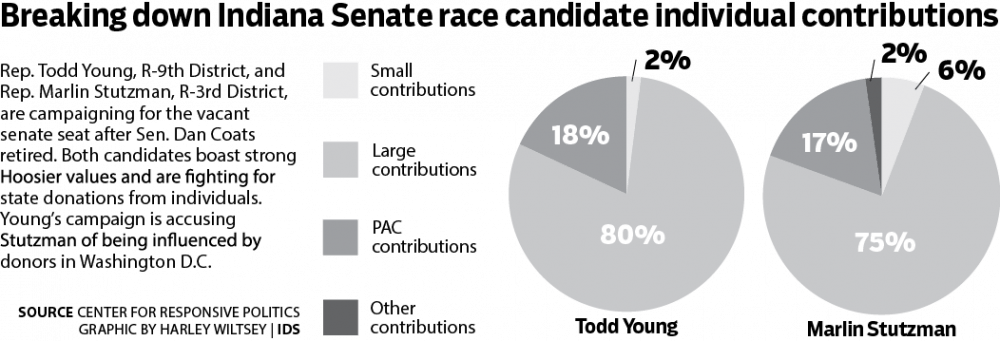Senate hopeful Rep. Todd Young, R-9th District, has received individual contributions from bookkeepers, homemakers and retirees.
Of these donations, 68 percent of them are from Indiana residents, according to the Federal Election Commission.
This is a point of pride for Young’s campaign.
“Having a large proportion of donors in-state shows that Hoosiers agree (with Young), and it’s a sign he’s earned the trust and support of the same people who will be casting ballots in the race,” campaign manager Trevor Foughty said in an email.
Young is campaigning against fellow Rep. Marlin Stutzman, R-3rd District, for Dan Coat’s open seat.
On Monday, Young’s campaign sent an email calling out Stutzman for his Washington, D.C., contributors. A tough blow considering both campaigns rely heavily on Hoosier values.
“How can Hoosiers trust a career politician since age 26 who’s bankrolled by out-of-state interests as our next senator?” Young’s campaign said in an email.
The email cited a Howey Politics Indiana article based on the FEC’s third-quarter report in October that calculated 61 percent of Stutzman’s total donations came from out-of-state and special interest groups.
“Marlin Stutzman has repeatedly tried to say that others in the race are funded by outside special interests, but the numbers indicate that actually describes his own campaign,” Foughty said in an email. “He fails to live up to the yardstick he’s laid out.”
Stutzman, a fourth generation hoosier farmer, stresses “guts, grits, and God’s grace” in his campaign videos. Similarly, Young’s campaign videos showcase “life in Indiana,” which appreciates “family, value and hard work.”
Despite this both candidates are receiving money from Washington, but just barely.
The FEC reports only 29 individual donations listed under Washington, D.C., for Stutzman and 45 for Young, both of which accumulate to less than 1 percent of the candidates’ individual contributions, according to the FEC’s two-year summary updated Dec. 31, 2015.
However, Stutzman is trailing behind Young in terms of Hoosier donations, with only 20 percent of his individual donations coming from in-state individuals, according to December FEC reports.
Both campaigns rely heavily on individual “large” contributors. The Indiana Election Commission defines large contributions as any amount equaling $1,000 or more.
Stutzman’s large individual donors have raised 74.5 percent of his overall funds. Young’s large contributions add up 80.3 percent of his overall campaign finance, according to FEC reports.
In total, Stutzman is about $1 million behind Young at $1,708,556, according to the FEC report.
Young’s financial success can, in part, be attributed to his political action committee money. He leads both Stutzman and Democratic candidate Baron Hill for most money from business PACs, according to FEC reports.
Finance, insurance and real estate sectors, such as wealth management company UBS Americas and health organization Cigna Corp, collectively contributed $149,500 to make up 86 percent of the PAC contribution for Young’s campaign, according to FEC reports.
In contrast, business PAC money only makes up 68 percent of Stutzman’s contributions, leaving the other 32 percent, or $86,910, to be funded from ideological or single-issue groups such as Concerned Women for America and Conservative America Now, according to FEC reports.
Although both candidates are raising and spending well over the average house member, neither campaign shows signs of “dark money,” said Will Tucker, reporter for Center for Responsive Politics.
Dark money, or funding without a required disclosed source or donation limitations, can affect a candidate’s quality of disclosure.
Currently, Young clocks in at 92.8 percent of his funds having full disclosure while only 87.2 percent of Stutzman’s are fully disclosed. This leaves 0.2 percent incomplete and 12.6 percent or $137,704 with no disclosure for Stutzman’s campaign.
Most of this undisclosed money could be attributed to refunds as well, Tucker said.
Voters looking for red flags shouldn’t let hot button issues like “dark money” and “super PACs” cloud their judgment, Tucker said.
“There’s so many different candidates and so many different strategies of people trying to win elections that you can get lost in the buzzwords,” Tucker said






